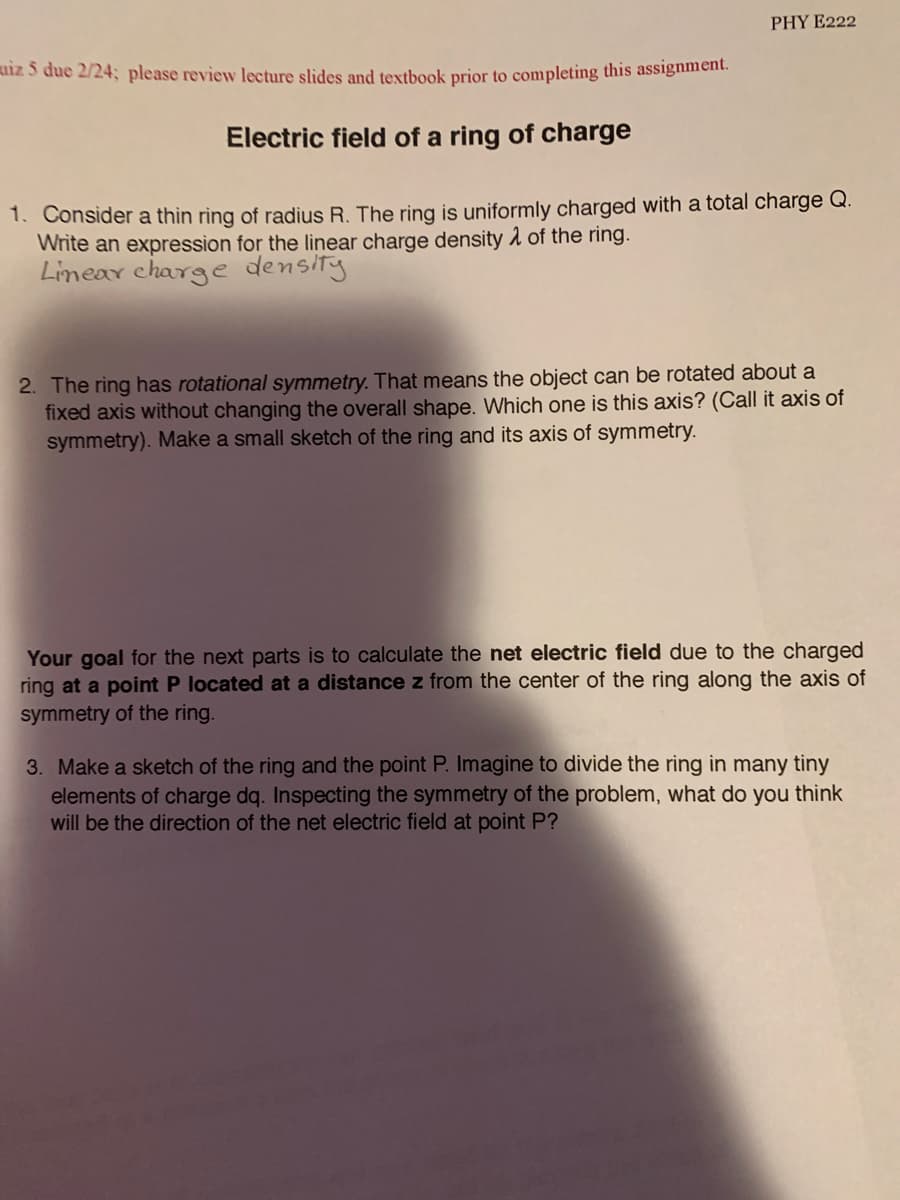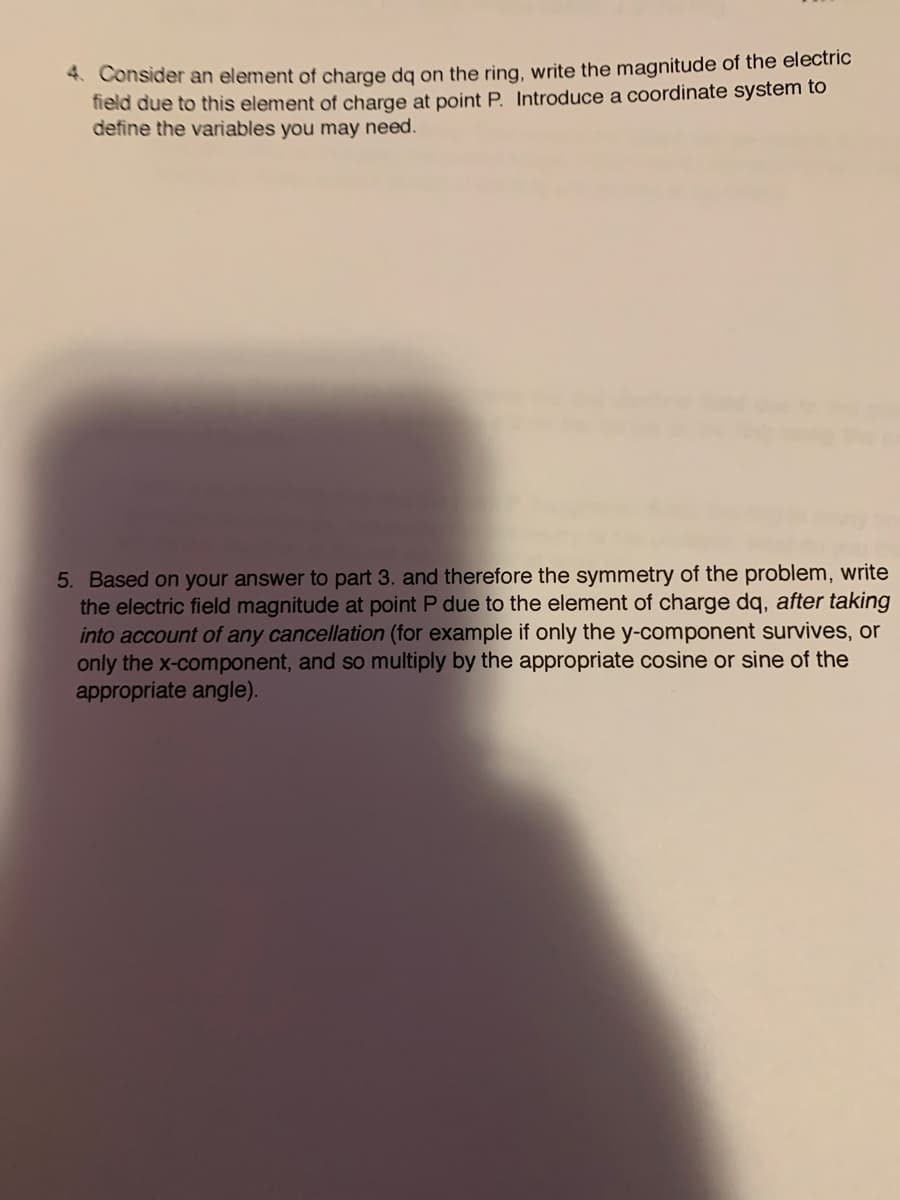1. Consider a thin ring of radius R. The ring is uniformly charged with a total charge Q. Write an expression for the linear charge density 1 of the ring. Linear charge density 2. The ring has rotational symmetry. That means the object can be rotated about a fixed axis without changing the overall shape. Which one is this axis? (Call it axis of symmetry). Make a small sketch of the ring and its axis of symmetry. Your goal for the next parts is to calculate the net electric field due to the charged ring at a point P located at a distance z from the center of the ring along the axis of symmetry of the ring. 3. Make a sketch of the ring and the point P. Imagine to divide the ring in many tiny elements of charge dq. Inspecting the symmetry of the problem, what do will be the direction of the net electric field at point P? you think
1. Consider a thin ring of radius R. The ring is uniformly charged with a total charge Q. Write an expression for the linear charge density 1 of the ring. Linear charge density 2. The ring has rotational symmetry. That means the object can be rotated about a fixed axis without changing the overall shape. Which one is this axis? (Call it axis of symmetry). Make a small sketch of the ring and its axis of symmetry. Your goal for the next parts is to calculate the net electric field due to the charged ring at a point P located at a distance z from the center of the ring along the axis of symmetry of the ring. 3. Make a sketch of the ring and the point P. Imagine to divide the ring in many tiny elements of charge dq. Inspecting the symmetry of the problem, what do will be the direction of the net electric field at point P? you think
Physics for Scientists and Engineers: Foundations and Connections
1st Edition
ISBN:9781133939146
Author:Katz, Debora M.
Publisher:Katz, Debora M.
Chapter24: Electric Fields
Section: Chapter Questions
Problem 79PQ
Related questions
Question
100%

Transcribed Image Text:PHY E222
uiz 5 due 2/24; please review lecture slides and textbook prior to completing this assignment.
Electric field of a ring of charge
1. Consider a thin ring of radius R. The ring is uniformly charged with a total charge Q.
Write an expression for the linear charge density 1 of the ring.
Linear charge density
2. The ring has rotational symmetry. That means the object can be rotated about a
fixed axis without changing the overall shape. Which one is this axis? (Call it axis of
symmetry). Make a small sketch of the ring and its axis of symmetry.
Your goal for the next parts is to calculate the net electric field due to the charged
ring at a point P located at a distance z from the center of the ring along the axis of
symmetry of the ring.
3. Make a sketch of the ring and the point P. Imagine to divide the ring in many tiny
elements of charge dq. Inspecting the symmetry of the problem, what do you think
will be the direction of the net electric field at point P?

Transcribed Image Text:4. Consider an element of charge dg on the ring, write the magnitude of the electric
field due to this element of charge at point P. Introduce a coordinate system to
define the variables you may need.
5. Based on your answer to part 3. and therefore the symmetry of the problem, write
the electric field magnitude at point P due to the element of charge dq, after taking
into account of any cancellation (for example if only the y-component survives, or
only the x-component, and so multiply by the appropriate cosine or sine of the
appropriate angle).
Expert Solution
Step 1
Given:
charge on ring = Q
radius of ring = R
Trending now
This is a popular solution!
Step by step
Solved in 4 steps with 2 images

Knowledge Booster
Learn more about
Need a deep-dive on the concept behind this application? Look no further. Learn more about this topic, physics and related others by exploring similar questions and additional content below.Recommended textbooks for you

Physics for Scientists and Engineers: Foundations…
Physics
ISBN:
9781133939146
Author:
Katz, Debora M.
Publisher:
Cengage Learning

Physics for Scientists and Engineers, Technology …
Physics
ISBN:
9781305116399
Author:
Raymond A. Serway, John W. Jewett
Publisher:
Cengage Learning

Principles of Physics: A Calculus-Based Text
Physics
ISBN:
9781133104261
Author:
Raymond A. Serway, John W. Jewett
Publisher:
Cengage Learning

Physics for Scientists and Engineers: Foundations…
Physics
ISBN:
9781133939146
Author:
Katz, Debora M.
Publisher:
Cengage Learning

Physics for Scientists and Engineers, Technology …
Physics
ISBN:
9781305116399
Author:
Raymond A. Serway, John W. Jewett
Publisher:
Cengage Learning

Principles of Physics: A Calculus-Based Text
Physics
ISBN:
9781133104261
Author:
Raymond A. Serway, John W. Jewett
Publisher:
Cengage Learning

Physics for Scientists and Engineers with Modern …
Physics
ISBN:
9781337553292
Author:
Raymond A. Serway, John W. Jewett
Publisher:
Cengage Learning

Physics for Scientists and Engineers
Physics
ISBN:
9781337553278
Author:
Raymond A. Serway, John W. Jewett
Publisher:
Cengage Learning
